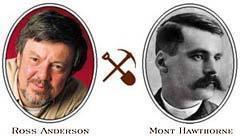
ABOARD THE FERRY COLUMBIA IN THE CHATHAM STRAIT - Our ship steams steadily northwest through channels so narrow you want to reach out and pluck spruce limbs from the shoreline, then into inland seas like this one, where vast expanses of sea and sky are bisected by distant, jagged mountain ranges.
From the stern of the ship, immersed in reading Mont Hawthorne's Klondike stories, I watch a school of porpoise frolicking in the ship's frothy wake. Each sighting of orcas or humpback whales, porpoise or bald eagles draws scores of fellow travelers to the rails, cameras whirring.
Beneath cloudless skies, surrounded by breathtaking views, a blissful air of freedom pervades our ship. The mood was established within minutes of leaving the dock at Bellingham. It lingers three days later as we approach our destination. We are the only ship on our horizon.
"This," says Capt. Ervin Hagerup, master of the Columbia, "is Alaska's best-kept secret."
The Columbia is outclassed by the grand cruise ships we pass along the way. There is no casino, no swimming pool, no stage show, no grand buffet with white-hatted chefs carving roast beef to order.
What we have are the essentials: the Inside Passage, a wilderness of spruce forests, tidewater glaciers, wildlife galore, plus good company and the romance of the North Country.
All this at Alaska Marine Highway fares a working stiff can afford without tapping the kids' college fund. My journey from Bellingham to Skagway covers 900 spectacular miles - more if you count detours to Southeast ports like Petersburg and Sitka. The price for three days of bliss, and seven feet of deck space for my tent, is $246.
Mont Hawthorne, my historical friend, and his dog Pedro, ride for free. Mont is impressed.
Hagerup, a compact and soft-spoken man with a thin moustache, surveys the lower decks, where 643 passengers are having their breath taken away.
"I've been cruising these waters for 30 years, and I never get tired of it," he says. "So imagine what it's like for folks from Iowa. They've been wanting to do this all their lives. And this is it."
The Inside Passage has been luring people north for more than a century. Even before the Klondike Gold Rush, frontier towns like Juneau and Sitka were attracting visitors. Salmon canneries drew fishermen and cannery workers, some of whom fell for the place and stayed.
But it took a national stampede to a Canadian goldfield 600 miles inland to truly market Alaska - and its gateway, Seattle - to the rest of the world. Even when the goldfields had played out, Alaska continued to fire the imagination.
Newspaper and magazine ads from early in the century sold package deals on Alaska steamers, many of them decked out with chandeliers, teak paneling, white linens, and hot and cold water.
Wealthy tourists from around the world helped to make fortunes for companies like Alaska Steamship. Alaska natives adapted their ancient handicrafts, carving miniature totems for the mantles of rich tourists.
But for most people, a northern adventure was out of reach.
The Alaska ferries, known as the Alaska Marine Highway, made it affordable. About 400,000 people each year board these prosaic but comfortable ships that link communities from Juneau to Wrangell to Metlakatla.
"It's easy to forget how isolated these communities are, particularly in the winter when flying is tough," Hagerup says.
In the summer, the Columbia is jammed with outside adventurers, tour groups, fortune-seekers - in some respects, the contemporary descendants of prospectors who plied these waters a century ago.
But most of the ferry system's clientele are Alaskans, whose most reliable link to neighbors and points south is this floating highway.
The system is in jeopardy. Its state subsidy is a juicy target for Interior Alaska politicians who dominate the state Legislature. They don't equate the ferry system's annual $25 million worth of red ink with a conventional highway.
Southeast Alaskans argue that fares are too high, schedules are inadequate and the fleet is aging. The state, they say, does a poor job marketing the profitable run to Washington state.
"To really appreciate all this, come back in the fall or spring, the shoulders of the season, when the weather is still pretty good, but the tourist traffic thins out," the skipper says. "That's when Alaskans like to ride these boats. It may get a bit tougher on the open water, but the overall atmosphere is more . . . well, more Alaskan. You sense that pioneer spirit."
I promise to do that.
But not now. Mont and I have a mission farther up North.